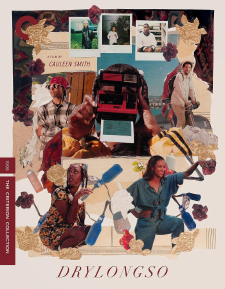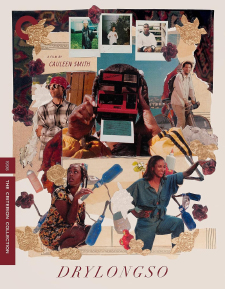Drylongso (Blu-ray Review)

Director
Cauleen SmithRelease Date(s)
1998 (August 29, 2023)Studio(s)
Nationsack Film Works/Janus Films (The Criterion Collection – Spine #1190)- Film/Program Grade: B+
- Video Grade: A
- Audio Grade: A
- Extras Grade: B-
Review
Set in 1990s Oakland, California, Drylongso is a story of female friendship, an ambitious non-conformist art school project, and a serial killer on the loose. The film played a number of festivals in the 90s and now is released on home video by The Criterion Collection.
Pica (Toby Smith) attends school by day and earns extra money at night by putting up posters announcing a community meeting to address a string of unsolved murders. She shares a home with her mother (Channel Schafer), whose main activity is partying with friends. In an attempt at privacy, Toby has installed a lock on her bedroom door.
A first-year photography student, Pica spurns the 35 mm format the professor requires. She doesn’t believe expressing herself requires a 35 mm camera. She insists on a Polaroid camera instead to avoid alarming her subjects—young Black men, whom she calls an endangered species, statistically the demographic most likely to die young. She has little patience with her classmates who pretentiously assess their own work in glowing terms. The professor (Salim Akil) is sympathetic to a degree but insists that she adhere to the course requirements. A final project is coming up and she must be ready.
Sitting on her porch one night, Pica witnesses a scene of brutality when a young woman, Tobi (April Barnett), is pulled from a car by her date, roughed up, and left crying at the curb. Pica asks if she’s OK and calls a cab for her. After her assault, Tobi abandons her high-fashion look for oversize jeans, flannel shirts, and bandanas whenever she leaves the house. Looking like a boy offers her freedom from catcalling and sexual harassment. It also enables her to move about undetected by her violent ex-boyfriend. Her disguise is so convincing that when Pica later encounters her at a bus stop, she asks to take “his” picture before recognizing who she is. The two women bond with Tobi looking after Pica when she suffers a bout of pneumonia. She also offers support for Pica’s unorthodox art class project, which has expanded to an empty lot in West Oakland.
Director Cauleen Smith elicits fine performances from her lead players. Toby Smith’s Pica is confrontational, yet at ease asking total strangers if she can take their picture. There’s tension at home with her mother, who devotes little attention to Pica so she’s pretty much on her own. She resents the stricture placed on her photography assignment and insists on making her own decisions. April Barnett is lovely as Tobi, who uses her smarts to sidestep an abusive relationship. Barnett conveys both nonchalance as she peels a twenty from a wad of bills to pay for a T-shirt and fear as her former boyfriend pounds at the door and demands that she let him in.
The term “drylongso” derives from the Gullah language of the African American coastal communities of Georgia and South Carolina. Over time, it has come to mean “ordinary.” Director Cauleen Smith portrays individuals of an Oakland community—ordinary people on the surface—who possess drive and a desire for more than their environment provides. Pica and Tobi are bright young women who want to rise from their circumstances to seek a better life. They see in each other a kindred spirit and become nonjudgmental pals. Pica’s Mom shows little interest in her aspirations and Tobi’s mother is deceased, so their backgrounds are similar.
The film touches on several genres—the buddy film, horror, and romance—while presenting social commentary in a non-preachy manner. Shot on a low budget, it moves briskly and the two leads are quite good. Smith’s Pica is outspoken, unafraid to challenge her teacher, and knows what she wants out of school. She’s not there to absorb theory after theory without learning how to apply her talent. Impatient, she recognizes that a disturbing reality can have an application in art and determines to achieve her personal goal of creating an installation that will draw attention to a social tragedy.
Drylongso was shot by director of photography Andrew Black on 16 mm film and blown up to 35 mm for its theatrical release. It’s presented in the aspect ratio of 1.33:1. According to information in the enclosed booklet, this director-approved Blu-ray was created from the 16 mm original camera negative, which was scanned in 4K resolution on a Lasergraphics Director film scanner. Picture is very good, with details in Pica’s room, her art installation, Tobi’s hip hop-style clothing, and houses in Pica’s Oakland neighborhood nicely delineated. Complexions are rendered well, ranging from Tobi’s light skin tone to Pica’s darker skin. There are no scratches, cue marks, emulsion clouding or dirt specks, in keeping with The Criterion Collection’s high standards.
The soundtrack is English Mono LPCM. English SDH subtitles are an available option. The original monaural soundtrack was remastered from the 35 mm magnetic track. Dialogue is clear and distinct throughout. Sound overall is natural and without echos, dropouts, and excessive noise. Ambient sound is mixed well with dialogue. Notable sound effects include a struggle between Tobi and her boyfriend, an alcoholic woman who badmouths Pica and her art installation, the snapping of a Polaroid camera, and traffic noise.
Bonus materials on The Criterion Collection Blu-ray release include the following:
- Cauleen Smith and Michael B. Gillespie in Conversation (24:44)
- Short Films by Cauleen Smith:
- Introduction (12:08)
- Chronicles of a Lying Spirit by Kelly Gabon (6:07)
- Songs for Earth & Folk (10:41)
- Lesson in Semaphore (4:19)
- Egungun (Ancestor Can’t Find Me) (5:21)
- Remote Viewing (15:27)
- Suffolk (7:40)
- Theatrical Trailer (1:57)
Cauleen Smith and Michael B. Gillespie in Conversation – Cauleen Smith is referred to as a Black feminist filmmaker. Smith wanted to illustrate characters underrepresented in mainstream movies. The early 90s was the peak of the crack wars and violence was rampant. She had the idea of documenting pictures of Black men. At UCLA, she started writing Drylongso. In Los Angeles, bodies were found every few days and she was personally terrified by a serial killer on the loose. Some of the directors who inspired her are Fellini, Charles Burnett, and Julie Dash. She had to let the audience know how Pica feels about her photographs, and that led to the scene of the neighborhood art installation.
Introduction – Director Cauleen Smith provides an overview of the several short films included.
Chronicles of a Lying Spirit – Shot on 16 mm in 1992, Smith employs her alter-ego, Kelly Gabon, and a collage of images, texts, and voices to fabricate a history in which the presence of Black women is reinserted into histories that often render them invisible.
Songs for Earth & Folk – Made in 2013, this short is composed entirely of 16 mm and Super 8 found footage and is structured like a blues song, with a live improvised electro-organic soundtrack created by Chicago-based band the Eternals.
Lesson in Semaphore – In this 16 mm silent film shot by Smith on the South Side of Chicago in 2016, choreographer taisha padgett dances with two flags in an attempt to communicate in semaphore. She meets a young boy, Malik, who appears to speak her language.
Egungun (Ancestor Can’t Find Me) – This 2017 16 mm film features a masked, warrior-like figure shrouded in shells, feathers, and coral wandering across a lush landscape.
Remote Viewing – Connecting sites and incidents, this 2011 film, shot on digital video, is a reenactment of a deeply impactful event as remembered by a man looking back on his childhood.
Suffolk – This music video was commissioned in 2021 by musician Jeff Parker for his solo guitar composition Suffolk. The video complements director Cauleen Smith’s short film Sojourner (2018), which was partially shot at Noah Purifoy’s outdoor museum in Joshua Tree, California, and features footage from that film.
Booklet – The accordion-style booklet contains the essay A Refuge of Their Own by Yasmania Price, cast and crew credits, information about the film’s digital transfer and, when fully opened, a 19” X 13” full-color poster of the Blu-ray’s cover art.
Shot on 16 mm, Drylongso is effective in showing everyday individuals going through everyday situations trying to make the best of what life has given them. April Barnett is so lovely, even disguised as a boy, she isn’t convincing. The dark glasses help, but her delicate features are definitely feminine. Director Smith keeps her story grounded, but there are a couple of scenes that fail to ring true, and seem more Hollywood than Cauleen Smith. Though the specter of a killer on the loose haunts the film, it’s just one of the things Pica and her friends have to cope with. Resilient, defiant, and determined, they persevere against all odds. Smith’s characters are believable, flawed, and sympathetic. The dialogue is authentic, and the acting impressive.
- Dennis Seuling

